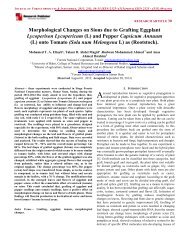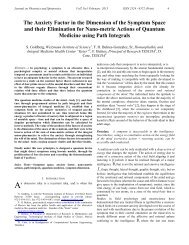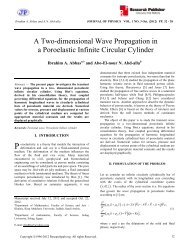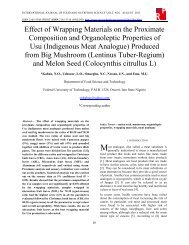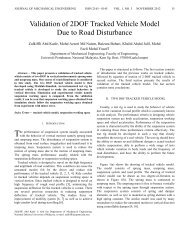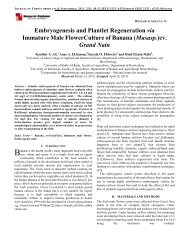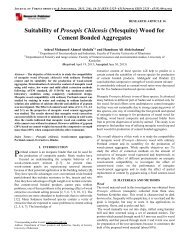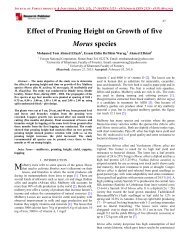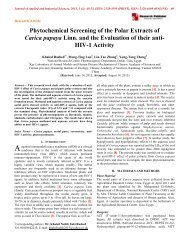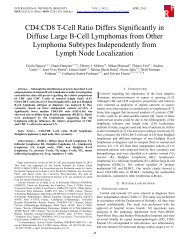Estrogen Impact on Autoimmunity Onset and Progression: the ...
Estrogen Impact on Autoimmunity Onset and Progression: the ...
Estrogen Impact on Autoimmunity Onset and Progression: the ...
- No tags were found...
You also want an ePaper? Increase the reach of your titles
YUMPU automatically turns print PDFs into web optimized ePapers that Google loves.
INTERNATIONAL TRENDS IN IMMUNITY VOL.1 NO.2 APRIL 2013ISSN 2326-3121 (Print) ISSN 2326-313X (Online) http://www.researchpub.org/journal/iti/iti.html<strong>the</strong>ir high levels in humans under certain nutriti<strong>on</strong>alc<strong>on</strong>diti<strong>on</strong>s could induce significant biologicaleffects. Although an extensive literature showed thatgenistein exerts a dose dependent suppressi<strong>on</strong> ofboth humoral <strong>and</strong> cell-mediated immune resp<strong>on</strong>ses,o<strong>the</strong>r studies reported that genistein or o<strong>the</strong>rphytoestrogens stimulate various aspects of immunefuncti<strong>on</strong> [81, 82]. In autoimmune pr<strong>on</strong>eMRL/Mp-lpr/lpr (MRL/lpr) mice, a soy diet (20%soybean protein <strong>and</strong> 5% soybean oil) was found toexacerbate renal damage, leading to acceleratedproteinuria, elevated serum creatinine, reducedcreatinine clearance, <strong>and</strong> increased glomerulardisease severity [83]. In c<strong>on</strong>trast, a study by H<strong>on</strong>g etal. [84] showed that dietary supplementati<strong>on</strong> of soyisoflav<strong>on</strong>es decreased serum anti-dsDNA IgG <strong>and</strong>anticardiolipin IgG levels, decreased IFN-γsecreti<strong>on</strong> from stimulated T cells, <strong>and</strong> prol<strong>on</strong>ged lifespan in MRL/lpr mice. Similarly, alfalfa sproutethyl acetate extract prol<strong>on</strong>ged <strong>the</strong> life span ofMRL/lpr mice [85]. A mild beneficial effect <strong>on</strong>lupus disease was also exerted by a low dose ofcoumestrol (a phytoestrogen in alfalfa) in (NZB ×NZW)F1 mice [86]. Overall, a generalizedc<strong>on</strong>clusi<strong>on</strong> c<strong>on</strong>cerning whe<strong>the</strong>r phytoestrogens havebeneficial or detrimental immune effects is notpossible. Future studies should take into accountthat a particular exposure could have differentimmune effects depending <strong>on</strong> <strong>the</strong> species, sex, levelof exposure, dosing regimen, <strong>and</strong> age at exposure.B. Oral c<strong>on</strong>traceptives <strong>and</strong> horm<strong>on</strong>e replacement<strong>the</strong>rapyDiethylstilbestrol (DES), a syn<strong>the</strong>tic estrogen withstr<strong>on</strong>g estrogenic activity, was prescribed in <strong>the</strong> pastto pregnant women to ameliorate problems duringpregnancy. It caused adverse effects <strong>on</strong> <strong>the</strong> femaleoffspring known as ‘‘DES daughter syndrome’’ [87].Limited studies in humans have suggested thatDES-exposed women developed a variety of ADs[88]. Animal studies have c<strong>on</strong>firmed that DES hasprofound immunomodulatory effects, including <strong>the</strong>inducti<strong>on</strong> of autoantibodies to cardiolipin [89]. Theseresults are c<strong>on</strong>sistent with findings by Yurino et al.[77] who showed that DES implant resulted inincreased IgG anti-DNA antibody producti<strong>on</strong> <strong>and</strong>immune complex depositi<strong>on</strong> in ovariectomized(NZB × NZW)F1 mice. Even if it is no l<strong>on</strong>ger usedduring pregnancy, exposure to DES may occurthrough c<strong>on</strong>sumpti<strong>on</strong> of milk <strong>and</strong> meat productsfrom animals that received DES as a food additive.17α-ethinyl estradiol (EE), a syn<strong>the</strong>tic analog of E2,is a primary comp<strong>on</strong>ent in horm<strong>on</strong>al c<strong>on</strong>traceptives<strong>and</strong> it is also used in horm<strong>on</strong>e replacement <strong>the</strong>rapy.Clinical trials have now proven that <strong>the</strong> use ofhorm<strong>on</strong>al c<strong>on</strong>traceptive in SLE patients with stablediseases does not increase <strong>the</strong> risk of flare [90].Differently, mild to moderate flares, but not severeflares, are increased in women under horm<strong>on</strong>ereplacement <strong>the</strong>rapy [91]. EE as well as E2 have beenalso identified in <strong>the</strong> envir<strong>on</strong>ment, most prominentlyin <strong>the</strong> aquatic envir<strong>on</strong>ment where <strong>the</strong> main sources ofc<strong>on</strong>taminati<strong>on</strong> are sewage treatment plants <strong>and</strong>agricultural runoff or discharge [92]. EE tends to bepresent in <strong>the</strong> envir<strong>on</strong>ment at much lower levels thanE2 but it is more persistent <strong>and</strong> less volatile [93].Surprisingly, <strong>the</strong>re are no published reports <strong>on</strong> <strong>the</strong>effect of EE in animal pr<strong>on</strong>e to develop ADs <strong>and</strong>many key questi<strong>on</strong>s in relati<strong>on</strong> to potentialimmunologic effects of EE are unanswered. Studiesin animal models are needed to assess whe<strong>the</strong>rsub-acute or chr<strong>on</strong>ic exposure to EE at lowc<strong>on</strong>centrati<strong>on</strong>s affect <strong>the</strong> immune system, whe<strong>the</strong>rEE effects occur equally with regard to age (preversuspost-menopausal women), sex, <strong>and</strong> route ofexposure (subcutaneous <strong>and</strong> oral).C. Anti ERα antibodiesAlterati<strong>on</strong>s of T lymphocyte homeostasis <strong>and</strong> <strong>the</strong>producti<strong>on</strong> of multiple pathogenic autoantibodies,including antibodies specific to ER (anti-ERantibodies), have been repeatedly dem<strong>on</strong>strated in<strong>the</strong> peripheral blood of patients with SLE [29, 94]. Ina recent study, our research group found thatautoantibodies specific to ERα (anti-ERα Abs) werepresent in 45% of SLE patients, <strong>and</strong> <strong>the</strong>y weresignificantly associated to clinical parameters, i.e.,<strong>the</strong> SLE Disease Activity Index <strong>and</strong> arthritis [95].Anti-ERα Abs are able to induce cell activati<strong>on</strong> <strong>and</strong>c<strong>on</strong>sequent apoptotic cell death in resting Tlymphocytes. C<strong>on</strong>versely, <strong>the</strong>y increase proliferati<strong>on</strong>of anti-CD3-stimulated T cells. The pro-apoptoticeffect of anti-ERα Abs <strong>on</strong> T lymphocytes mayc<strong>on</strong>tribute to <strong>the</strong> release of nuclear material in <strong>the</strong>circulati<strong>on</strong> that can represent an important source ofautoantigens if not timely removed. In this regard, animpaired clearance of dying cells is a typical featureof SLE where accumulati<strong>on</strong> of nuclear autoantigens29



